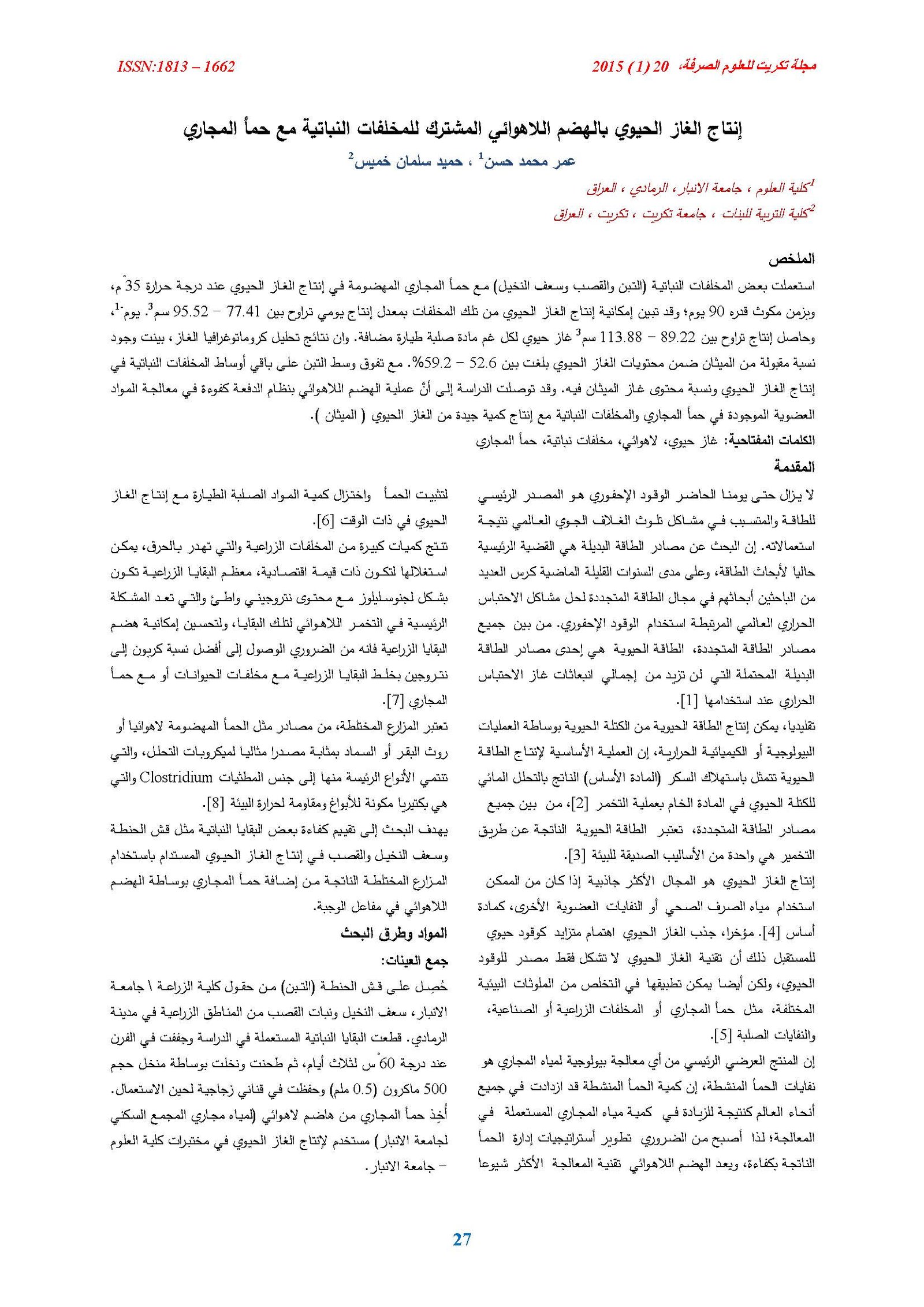Biogas production from sewage sludge by anaerobic digestion
Main Article Content
Abstract
Some plant residues with digested sewage sludge was used for biogas production at 35o C, and a retention time of 30 days; has been shown that possibility of producing biogas from primary sludge, with daily production rate about 77.41 - 95.52 cm3 biogas . day-1, and the average yield production between 89.22 - 113.88 cm3 biogas per g volatile solids added. And that the results of the gas chromatography analysis, show the presence of a acceptance percentage of methane within the contents of biogas between 52.6 - 59.2%. with surpass of wheat straw media over other plant residues media in biogas production and methane content rate. The study reached to that anaerobic digestion process with batch culture efficient in organic treatment presence in swage sludge with plant residues with good quantity of biogas (methane) production.
Article Details

This work is licensed under a Creative Commons Attribution 4.0 International License.
Tikrit Journal of Pure Science is licensed under the Creative Commons Attribution 4.0 International License, which allows users to copy, create extracts, abstracts, and new works from the article, alter and revise the article, and make commercial use of the article (including reuse and/or resale of the article by commercial entities), provided the user gives appropriate credit (with a link to the formal publication through the relevant DOI), provides a link to the license, indicates if changes were made, and the licensor is not represented as endorsing the use made of the work. The authors hold the copyright for their published work on the Tikrit J. Pure Sci. website, while Tikrit J. Pure Sci. is responsible for appreciate citation of their work, which is released under CC-BY-4.0, enabling the unrestricted use, distribution, and reproduction of an article in any medium, provided that the original work is properly cited.
References
[1] Lin C., and Chen H. (2006). Sulfate effect on fermentative hydrogen production using anaerobic mixed microflora. Int. J. Hydrogen Energy. 31 (7): 953-960.
[2] Wang J., and Wan W. (2009). Factors influencing fermentative hydrogen production: a review. Int. J. Hydrogen Energy. 34 (2): 799-811.
[3] Saha B. (2003). Hemicellulose bioconversion. J. Ind. Microbiol. Biotechnol. 30 (5): 279-291.
[4] Chang A.C., Tu Y., Huang M., Lay C., and Lin C. ( 2011 ). Hydrogen production by the anaerobic fermentation from acid hydrolyzed rice straw hydrolysate. int. J. of hydrogen energy. 36: 14280-14288.
[5] Kim M., Yang Y., Morikawa-Sakura M. S., Wanga Q., Lee M. V., Lee D., Feng C., Zhou Y., and Zhang Z. (2012). Hydrogen production by anaerobic co-digestion of rice straw and sewage sludge. int. J. of hydrogen energy. 37: 3142-3149.
[6] Athanasoulia E., Melidis P. and Aivasidis A. (2012). Optimization of biogas from waste activated sludge through serial digestion. Renewable Energy. 47: 147-151.
[7] Chin-Chao Chen a, and etal. (2012). Thermophilic dark fermentation of untreated rice straw use in mixed cultures for hydrogen production. international journal of hydrogen energy. 1 -7.
[10] APHA (American public Health Association). (1999). Standard methods for examination of water and wastewater, 20th Ed. Washington DC. USA.
[11] Datta, N.P., Khera, M.S. & Saini, T.R. (1962). A rapid colorimetric procedure for the determination of the organic carbon in soils. J. Ind. Soc. Soil Sci., 10: 67-74.
[12] AOAC (Association of Official Agricultural Chemist) (2002). Official methods of analysis , 17th Ed., method 978.04 ,Washington D.C., USA.
[13] Parajuli P. (2011). Biogas measurement techniques and the associated errors. Msc. Thesis, Department of Biological and Environmental Science, Faculty of Mathematics and Science, University of Jyväskylä.
[14] Pohl M., Mumme J., Heeg K., and Nettmann E. (2012). Thermo- and mesophilic anaerobic digestion of wheat straw by the upflow anaerobic solid-state (UASS) process. Bioresource Technology 124: 321-327.
[15] Teghammar A. (2013). Biogas Production from Lignocelluloses: Pretreatment, Substrate Characterization, Co-digestion, and Economic Evaluation. PhD thesis. Chalmers University of Technology, Göteborg, Sweden.
[16] Kymäläinen M., Lähde K., Arnold M., Kurola J.M., Romantschuk M., and Kautola H. (2012). Biogasification of biowaste and sewage sludge -
Measurement of biogas quality. Journal of Environmental Management, 95: S122-S127.
[17] Kerga, G.A. (2011). Optimum production of Biogas from Bio-Municipal solid Wastes Using Two stages Anaerobic Digester. Msc Thesis. Addis Ababa university.
[18] Pipyn P. and Verstraete, W. (1980). Waste classification for digestibility in anaerobicnsystems. In Anaerobic digestion (e.d.) D.A. Stafford, Vol. 1, p. 15-35. scientific press, cardiff.
[19] Stafford D.A., Hawkes D.L. and Horton R. (1980). Methane production from waste organic matter. Boca Raton, FL: CRC Press. USA.
[20] Andersson, S. (2011). Characterization of Microbial community structure in solidwaste bioreactors. postdoctoral research, Royal institute of technology. Ardhi university, sweden.
